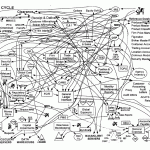 A client I worked with about 20 years ago recently discovered something shocking. The carefully created process his company developed to get from initial meeting to satisfied client—a process that worked well when I was working with them—had ballooned from 40 steps to more than 600! It had become a monster. As we discussed his problem, I realized that organizations are just bigger versions of ourselves, and that we’re all in danger of creating these kinds of monsters within.
A client I worked with about 20 years ago recently discovered something shocking. The carefully created process his company developed to get from initial meeting to satisfied client—a process that worked well when I was working with them—had ballooned from 40 steps to more than 600! It had become a monster. As we discussed his problem, I realized that organizations are just bigger versions of ourselves, and that we’re all in danger of creating these kinds of monsters within.
As organizations and processes grow, Knower/Judger rules are required to manage them. This is simply a matter of efficiency. Companies can’t afford the resources required to look at occurrences from the Learner/Researcher perspective continually.
In his book The E-Myth Revisited, Michael Gerber explains that making these K/J rules is a requirement to grow from entrepreneurial (where your business owns you) to fully functional (where you own your business). Simply put, you need to let go of the day-to-day, shoot-from-the-hip decision making so romantically attached to the entrepreneurial spirit. Instead, you systematize the processes and oversight in such a way that anyone can achieve the desired result.
You put your K/J rules for how things should be done on paper for others to follow.
This works. You’re able to hire employees and no longer have to do each task yourself.
Then one day an error occurs. To ensure it doesn’t happen again, someone builds an error-checking loop into the process. Bingo! Fifteen more steps.
Over time, new talents and equipment get added to the mix. More steps. Lo and behold, 20 years later, 40 steps become 600. No one knows how some of these steps got involved or even what purpose they serve…but they’re still there
When we attempt to alter the rules in a bureaucracy, we often find it virtually impossible because people want to do things the way they’ve always done them. A change attempted by management, who looked at the data and made the choice to change in order to work more efficiently, is short-circuited by history, in the guise of embedded processes, taking charge.
We’ve all experienced the long-term employee who can’t get used to the concept of using text messaging for data dispensing or the receptionist who used to work for the CEO’s dad when he worked for the company. Then there’s the customer service rep thumbing through the rulebook telling you why she can’t refund your money for the duplicate widget you just bought (and losing a customer). Or the clerk at the license bureau.
Those characters exist within us, affecting our interaction with the world on a daily basis. We’ve all got steps and processes embedded in our K/J rules of life for which we have no current justification. Yet they’re still there, and in many ways they dictate our experiences.
Being aware of these extraneous and counterproductive steps, or K/J rules, can go a long way to improve efficiency and relationships.



